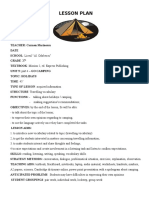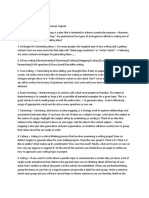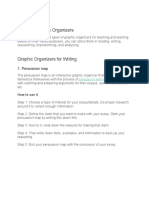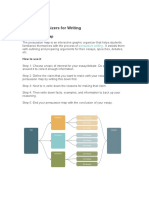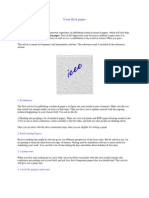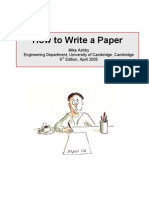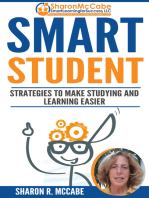Professional Documents
Culture Documents
Note Taking Activities
Note Taking Activities
Uploaded by
Helen BurnOriginal Description:
Original Title
Copyright
Available Formats
Share this document
Did you find this document useful?
Is this content inappropriate?
Report this DocumentCopyright:
Available Formats
Note Taking Activities
Note Taking Activities
Uploaded by
Helen BurnCopyright:
Available Formats
Activity 1:
Incredible Shrinking Notes… or how to write a
precis (summary)!
1. Read the article on the co-discovery of “the double-helix structure of DNA,
which formed the basis for modern biotechnology:”
https://www.chemheritage.org/historical-profile/james-watson-francis-crick-
maurice-wilkins-and-rosalind-franklin (23/01/17)
2. Fill a 3- x 5-inch (roughly 7.6x 12.7cm) sticky note or index card with
important facts from the reading selection.
3. Narrow down those notes to the important notes that fit on a medium-size
(approximately 3- x 3-inch or 7.7cm square) sticky note or card.
4. Narrow down those notes again to the most important notes that will fit on a
small (approximately 1x 2 inch - 2.5 x 5cm) small sticky note or card
Activity 2:
Mind-mapping… (for those who can’t draw)!
http://www.studygs.net/mapping/exercise1.htm (23/01/17) - (you can use any
other FREE mind-mapping software)
1. In the centre Topic circle, enter a word or phrase that best summarises your
topic (you can choose)
2. Click on the red button to add a related key idea-- words, phrases, etc.
3. Add supporting ideas by clicking on their red buttons within the key idea
4. Add additional key and supporting ideas
5. Edit Think about the relation of outside items to the centre.
Delete, replace, and shorten words for key and supporting ideas.
6. Print!
for your review and use in organizing your writing, developing projects,
studying for tests, brainstorming ideas, and in general apply a more meaningful
learning exercise to what you are studying.
Access / Communication / Note-taking
Activity 3:
Research Note-
taking…or how to
avoid plagiarism!
Good for an introduction to a new
research topic. You might want to
start by creating a KWL chart (See
image alongside).
1. Brainstorm information
you Know about your chosen
topic and write it in the K
column.
Brainstorm a list of questions you Want to know about the subject and write them in
the W column. Save the KWL chart for use at the end of the lesson.
2. Select three questions you are most interested in learning about (or your
lecturer might assign one question to each student). You can then choose the
other two questions.
3. Use a word processing program to type the three questions into the
"Research Question" field on the Note-Taking Graphic Organiser (See
example below – the organiser will be on Moodle
4. Next, use library and or Internet to search for the information to answer the
three questions on their charts. Identify three "Research Sources" and write
Access / Communication / Note-taking
the answers you find in those sources in the appropriate columns in the Note-
Taking Graphic Organiser.
The spaces on the graphic organizer are particularly small so write brief
notes (using key phrases and words) rather than entire sentences.
Now write a report that includes a summary paragraph or two about each of
the questions they researched.
5. Now fill in the L column on your KWL chart with the information you have
learnt.
Access / Communication / Note-taking
You might also like
- Go Camping Lesson PlanDocument3 pagesGo Camping Lesson PlanNela VasileNo ratings yet
- PBL Lesson Plan Template Ian EliDocument12 pagesPBL Lesson Plan Template Ian Eliapi-643688179No ratings yet
- Reinforcement Worksheet Term 2Document2 pagesReinforcement Worksheet Term 2Sam JavelaNo ratings yet
- How We Express Ourselves Newsletter EnglishDocument3 pagesHow We Express Ourselves Newsletter Englishapi-269131865100% (1)
- Research ChecklistDocument11 pagesResearch Checklistapi-225856477No ratings yet
- Cornell Notes PresentationDocument23 pagesCornell Notes PresentationlhelgersonNo ratings yet
- Techniques in Selecting and Organizing InformationDocument7 pagesTechniques in Selecting and Organizing InformationReniel CabunganNo ratings yet
- An Interactive Notebook: World History Conversational History JournalDocument5 pagesAn Interactive Notebook: World History Conversational History Journalapi-237533129No ratings yet
- How To Write A Research PaperDocument6 pagesHow To Write A Research PaperLiby BabuNo ratings yet
- Chapter 1Document34 pagesChapter 1Mia KulalNo ratings yet
- Annotated TemplateDocument13 pagesAnnotated Templatedebashishsarangi2No ratings yet
- Lesson Study: Active Learning: DefinitionDocument7 pagesLesson Study: Active Learning: DefinitionNhuận Lê ThanhNo ratings yet
- Generating IdeasDocument2 pagesGenerating IdeasShaistaNo ratings yet
- Grade 10 English Session 1.9Document3 pagesGrade 10 English Session 1.9Mereyl delpuertoNo ratings yet
- Active Learning Lesson Plan TemplateDocument7 pagesActive Learning Lesson Plan TemplateANDREZZA ANDIENo ratings yet
- Tips On Scientific Writing: 1 Elements and StructureDocument5 pagesTips On Scientific Writing: 1 Elements and StructureAlexandra BarthNo ratings yet
- 20 Steps To Writing A Research ArticleDocument4 pages20 Steps To Writing A Research ArticleDhanunjayaNo ratings yet
- How To Write An Introduction For Science CourseworkDocument7 pagesHow To Write An Introduction For Science Courseworkf1vijokeheg3100% (1)
- Basic Steps in Essay Writing: Step 1: Select The QuestionDocument5 pagesBasic Steps in Essay Writing: Step 1: Select The QuestionGoudaKamal AliNo ratings yet
- Note Taking 2Document10 pagesNote Taking 2Fiddle ThomasNo ratings yet
- Generate Ideas About A TopicDocument3 pagesGenerate Ideas About A Topicapi-307221816No ratings yet
- Analysis of Data-Pr1Document9 pagesAnalysis of Data-Pr1melody.magahisNo ratings yet
- 393-Irp-Spring17 1Document7 pages393-Irp-Spring17 1api-352487017No ratings yet
- Types of Graphic OrganizersDocument24 pagesTypes of Graphic OrganizersRia LucenaNo ratings yet
- 304 ChoiceboardDocument1 page304 Choiceboardapi-450506896No ratings yet
- Sciencefair Packet - 12Document28 pagesSciencefair Packet - 12Tetsuya KurokoNo ratings yet
- Research Guide MsDocument45 pagesResearch Guide MsAlexandra UlrichNo ratings yet
- Science Fair Student GuideDocument2 pagesScience Fair Student Guideapi-235776194No ratings yet
- Creative Nonfiction Week 1 8Document5 pagesCreative Nonfiction Week 1 8Roselyn Bustarga100% (1)
- ES1103 Tutorial 8Document19 pagesES1103 Tutorial 8dessohNo ratings yet
- Graphic Organizer Group 5Document40 pagesGraphic Organizer Group 5Niño Dwayne TuboNo ratings yet
- Year 10 Sociology Summer TaskDocument10 pagesYear 10 Sociology Summer Taskapi-264819644No ratings yet
- E TOOLKIT Training Materials For Creative Reading and WritingDocument53 pagesE TOOLKIT Training Materials For Creative Reading and WritingSummer BaroneNo ratings yet
- Research Capstone: Page 1 of 8Document8 pagesResearch Capstone: Page 1 of 8Editha FernandezNo ratings yet
- Guide To Prospectus Writing: 1 Objectives and AudienceDocument5 pagesGuide To Prospectus Writing: 1 Objectives and AudiencerojasyNo ratings yet
- Writing First Draft Research PaperDocument7 pagesWriting First Draft Research Paperafmcmuugo100% (1)
- Lecture 4 PPT 2 - BrainstormingDocument8 pagesLecture 4 PPT 2 - BrainstormingAbdullah AamirNo ratings yet
- Graphic Organizers For Writing: 1. Persuasion MapDocument19 pagesGraphic Organizers For Writing: 1. Persuasion MapRose ann rodriguezNo ratings yet
- Case Analysis WorksheetDocument2 pagesCase Analysis Worksheetdiego.andradecNo ratings yet
- How To Write A PaperDocument5 pagesHow To Write A PaperclairesanjeevNo ratings yet
- RWS-L2-Techniques in Selecting and Organizing InformationDocument142 pagesRWS-L2-Techniques in Selecting and Organizing InformationArnold SilverioNo ratings yet
- Study Tips On MedschoolDocument6 pagesStudy Tips On MedschoolArgyll BongosiaNo ratings yet
- Skimming and Scanning (Activities Included)Document4 pagesSkimming and Scanning (Activities Included)juanelga100% (1)
- Points To Note While Preparing Your Abstracts For 4 Wac:: ND RD THDocument7 pagesPoints To Note While Preparing Your Abstracts For 4 Wac:: ND RD THKrutik ShahNo ratings yet
- Part I - Content Update: 1. What Are Study Skills?Document18 pagesPart I - Content Update: 1. What Are Study Skills?Edward AlmazanNo ratings yet
- Synthesizing Information: Step-by-Step Instructions For LearnersDocument3 pagesSynthesizing Information: Step-by-Step Instructions For LearnersRomelSorianoLadislao100% (1)
- Ashby How To Write A PaperDocument47 pagesAshby How To Write A PaperGauri RanadiveNo ratings yet
- Research Skills Course - Writing A Review of The LiteratureDocument7 pagesResearch Skills Course - Writing A Review of The LiteraturecuongaccNo ratings yet
- FL3061 Unit 6 f2f PaperbookDocument8 pagesFL3061 Unit 6 f2f PaperbookTrí Dũng TrầnNo ratings yet
- Ejemplo para La Redacción Del Caso de EstudioDocument14 pagesEjemplo para La Redacción Del Caso de EstudioMaria Fernanda Romero AyerbeNo ratings yet
- Magazine ProjectDocument3 pagesMagazine Projectapi-329349491100% (1)
- Projects SlidesDocument67 pagesProjects SlidesTarique ansariNo ratings yet
- Lesson 9 - Reading As A Process (Part 2 and 3) PDFDocument26 pagesLesson 9 - Reading As A Process (Part 2 and 3) PDFmohapisthaba77No ratings yet
- How To Write A Paper - Asbhy 2011Document26 pagesHow To Write A Paper - Asbhy 2011Shlim ShadeNo ratings yet
- Sdo Laguna Stem-P Research Ii Worksheet: Quarter 3Document7 pagesSdo Laguna Stem-P Research Ii Worksheet: Quarter 3tolisNo ratings yet
- Writing SeriesDocument5 pagesWriting SeriessokkanlingamNo ratings yet
- Paper ReadingDocument2 pagesPaper ReadingnasierrasNo ratings yet
- Note MakingDocument7 pagesNote MakingabdulNo ratings yet
- Smart Student: Strategies to Make Studying and Learning EasierFrom EverandSmart Student: Strategies to Make Studying and Learning EasierNo ratings yet
- Bharat Intern Machine LearningDocument8 pagesBharat Intern Machine LearningAkfashion StudioNo ratings yet
- Pride Mukwachari CVDocument13 pagesPride Mukwachari CVpride mukwachariNo ratings yet
- Training SchemeDocument1 pageTraining SchemeKem RaiNo ratings yet
- Year 8 2017Document8 pagesYear 8 2017api-346659195100% (1)
- Scope and Sequence Practical Research 2Document2 pagesScope and Sequence Practical Research 2Tek CasoneteNo ratings yet
- Possible TitleDocument49 pagesPossible TitlekudokunNo ratings yet
- Unit 6:: Other Laws Relevant To The Teaching ProfessionDocument11 pagesUnit 6:: Other Laws Relevant To The Teaching ProfessionRobert C. Barawid Jr.100% (1)
- Scheme of Examination Total Marks: 100 Theory: 80 Internal Assessment: 20 Time: 3 HrsDocument1 pageScheme of Examination Total Marks: 100 Theory: 80 Internal Assessment: 20 Time: 3 HrsHemlata BatnagarNo ratings yet
- Subject: Language 1 Semester Lesson Planning SY 2017-2018 Prepared By: - Grade: KG 3/1 Approved By: - Week / Date Content Evaluation After ClassDocument3 pagesSubject: Language 1 Semester Lesson Planning SY 2017-2018 Prepared By: - Grade: KG 3/1 Approved By: - Week / Date Content Evaluation After Classclarence acostaNo ratings yet
- Hailey Aguirre Equity EssayDocument2 pagesHailey Aguirre Equity Essayapi-252496439No ratings yet
- Academic Registry: Enhanced Disclosure From The Disclosure & Barring Service Applicantchecks@uel - Ac.ukDocument2 pagesAcademic Registry: Enhanced Disclosure From The Disclosure & Barring Service Applicantchecks@uel - Ac.ukMonhart Agnes MelinaNo ratings yet
- Department of Education: Lingunan National High SchoolDocument4 pagesDepartment of Education: Lingunan National High SchoolJoseph CastañedaNo ratings yet
- Experiential Education - Coffey - 2015Document2 pagesExperiential Education - Coffey - 2015Chara AgaoglouNo ratings yet
- Alia Burlew - ResumeDocument2 pagesAlia Burlew - Resumeapi-299915070No ratings yet
- Reading Worksheet Daily ActivitiesDocument2 pagesReading Worksheet Daily Activitiesun chico llamado kaidesNo ratings yet
- Metacognitive Analogy IntructionDocument21 pagesMetacognitive Analogy IntructionPat BitaraNo ratings yet
- 2020-2021 TranscriptDocument1 page2020-2021 Transcriptapi-521420967No ratings yet
- Finn de Bruin 2019-2020 2Document3 pagesFinn de Bruin 2019-2020 2api-518598757No ratings yet
- UntitledDocument9 pagesUntitledJohn Emmanuel AsuncionNo ratings yet
- SLACDocument21 pagesSLACRosa Villaluz BanairaNo ratings yet
- Hanh - Presentaion LV EDITED 5.4Document19 pagesHanh - Presentaion LV EDITED 5.4Mai BuiNo ratings yet
- A212 Bkai3043 - Group AssignmentDocument3 pagesA212 Bkai3043 - Group AssignmentSyazana RosliNo ratings yet
- The Little PrinceDocument6 pagesThe Little PrinceRosario Patino100% (3)
- Free GRE General Test Preparation Materials: Book: BARRON'SDocument25 pagesFree GRE General Test Preparation Materials: Book: BARRON'SzfrkhnNo ratings yet
- Stagizine 2018Document45 pagesStagizine 2018zoibaNo ratings yet
- April 3, 2020: Cherrylou D. Repia, Ceso VDocument12 pagesApril 3, 2020: Cherrylou D. Repia, Ceso VSonny MatiasNo ratings yet
